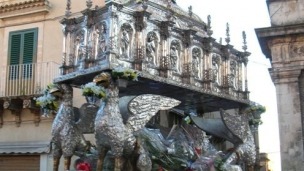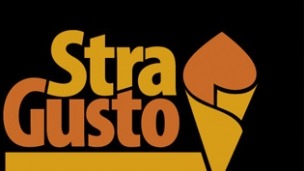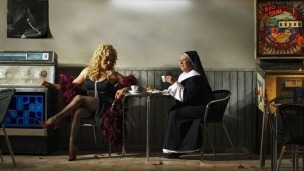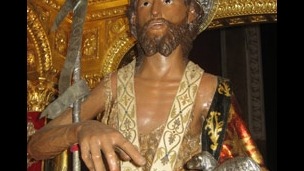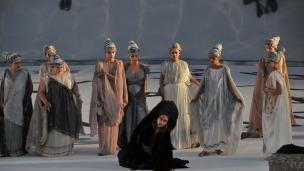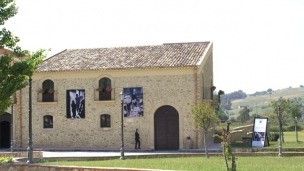Presepe Vivente in Ispica
The tradition of the Christmas Crib or Nativity Scene is still very strong in Italy and in most homes, stores and town squares you will find both a Christmas tree and a 'presepe' - as the crib is called. Before the 25th of December "'il Gesù bambino" - the protagonist of the presepe - is missing with Maria and Giuseppe watching over an empty crib. Right at midnight on Christmas day the baby gains his place at the centre of the crib.
The tradition of Nativity scenes has grown to include very elaborate structures with moving parts, lights and sound effects - of which Caltagirone in Sicily has some very famous examples. These end up being complete reconstructions of entire villages with all the traditional 'mestieri' - trades - from the shoemaker, the bread maker, the iron smith and so forth represented.
A more recent tradition is that of the 'presepe vivente' - or live nativity scene. The entire scene (including the enactment of all the different trades) is reconstructed with real people, tools, etc. Today - the day of "Epifania" and in Italy the real day in which children traditionally received presents - we visited the "Presepe Vivente" of Ispica, a very enjoyable walk amongst the caves that where the actual dwellings of some of the people from this town until even the early 1950s. Below we have some pictures we hope you enjoy.
 We were greeted with a scene of a team of workers preparing hay for transportation.
We were greeted with a scene of a team of workers preparing hay for transportation.

 Further on a group of young and old people where demonstrating how baskets and containers in which ricotta cheese was kept were prepared.
Further on a group of young and old people where demonstrating how baskets and containers in which ricotta cheese was kept were prepared.
 Here we have a very realistic looking 'scarparu' - or shoemaker. The way he was handling the tools made it quite clear that this guy was not pretending. In fact, I think he just temporarily moved offices in the cave - just working as usual only with an audience.
Here we have a very realistic looking 'scarparu' - or shoemaker. The way he was handling the tools made it quite clear that this guy was not pretending. In fact, I think he just temporarily moved offices in the cave - just working as usual only with an audience.
 A fully functioning watermill actually grinding wheat, while the lady in the corner is sieving it.
A fully functioning watermill actually grinding wheat, while the lady in the corner is sieving it.


A stone-cutter carving out a really nice motif. We were also happy to see that next to the older gentleman there was a young(er) man working the stone. This means that for at least another generation Ispica will have someone able to take care of all the Liberty style buildings that are decorated with just these types of stones.

 A traditional home scene, with mother and daughters seaming and preparing pasta. It really does look like a scene out of a film but in small towns like Ispica it would not be surprising at all if this scene was just what the mother remembers from when she was 5 or 6 years old.
A traditional home scene, with mother and daughters seaming and preparing pasta. It really does look like a scene out of a film but in small towns like Ispica it would not be surprising at all if this scene was just what the mother remembers from when she was 5 or 6 years old.
 A couple preparing bread the traditional way - with a 'sbriuni'. The definition of good bread in these parts of Sicily is one that is compact and made from hard grain wheat. This tool allows the bread maker to really knead the dough well so as to get the right consistency in the final product. The man moves the lever up and down kneading the bread while the lady needs to turn the piece of dough round each time the lever goes up. It's harder than it looks since a lot of force is required, it's also all rather fast so good timing is paramount!
A couple preparing bread the traditional way - with a 'sbriuni'. The definition of good bread in these parts of Sicily is one that is compact and made from hard grain wheat. This tool allows the bread maker to really knead the dough well so as to get the right consistency in the final product. The man moves the lever up and down kneading the bread while the lady needs to turn the piece of dough round each time the lever goes up. It's harder than it looks since a lot of force is required, it's also all rather fast so good timing is paramount!


The reconstruction of olive production was well thought out. Two fundamental steps - the first one is pressing the olive into a soft paste using the donkey-powered mill. This paste is then placed into large round cloth containers which are pressed on the olive press and fresh olive oil is the result - the smell is unfortunately something we cannot transmit through a blog!
 While the two men where busy pressing the olive paste the donkey decided enough is enough - and took a break munching on the olives itself. After all this is 2006 and donkeys have better things to do.
While the two men where busy pressing the olive paste the donkey decided enough is enough - and took a break munching on the olives itself. After all this is 2006 and donkeys have better things to do.
 A grape press. There was decidedly much more wine-drinking than wine-making going on here. But after all it was a chilly evening and the guys need to keep themselves warm.
A grape press. There was decidedly much more wine-drinking than wine-making going on here. But after all it was a chilly evening and the guys need to keep themselves warm.
 Of course a presepe is not a presepe without the actual nativity scene - so here they are. Maria, Giuseppe and Gesù bambino (as acted out by the youngest child-actor of Ispica) patiently waiting for the arrival of the Re Magi - which according to tradition made it to the crib for the big event on the 6th of January.
Of course a presepe is not a presepe without the actual nativity scene - so here they are. Maria, Giuseppe and Gesù bambino (as acted out by the youngest child-actor of Ispica) patiently waiting for the arrival of the Re Magi - which according to tradition made it to the crib for the big event on the 6th of January.
There were many more trades represented but the ones above were the best pictures we had! In all a great evening. It was interesting to note that some of the trades are very much alive and kicking today (e.g. the stone-cutter), others are there but in a completely different form (the bread is still great in this part of Sicily, wine is getting better and better and so is olive oil), while, finally, others are clearly on their way out although a few craftsmen are still around (the shoemaker).


